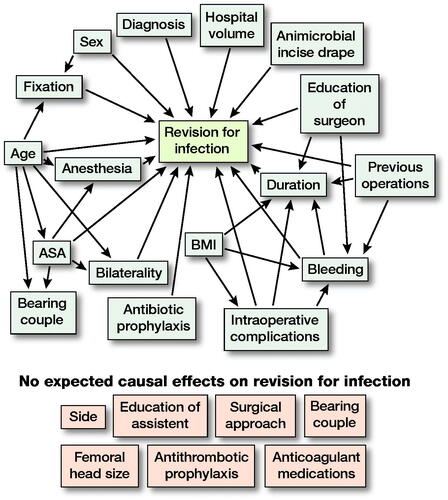Figures & data
Table 2. Univariable analysis of possible risk factors for revision for PJI
Figure 1. A directed acyclic graph (DAG) was constructed under the following assumptions:
1. THA “revision for infection” is dependent on “patient age,” “sex,” ‘bilaterality,” “ASA class,” “BMI,” “diagnosis,” “hospital volume,” “education of surgery,” “bleeding,” “duration,” “intraoperative complications,” “previous operations,” “antimicrobial incise drape,” “anesthesia,” “antibiotic prophylaxis,” and type of THA “fixation.” Choice of “side,” “education of assistant,” “surgical approach,” “bearing couple,” antithrombotic prophylaxis,” “anticoagulant medications,” and “femoral head size” are not expected to affect “revision for infection” due to clinical suspicion.
2. “Fixation” is dependent on “age” and “sex” because older and female patients have probably received a cemented or hybrid THA due to their poorer bone quality. “Bearing couple” may be dependent on age because surgeons have probably chosen ceramic-on-ceramic bearing couple in younger patients. “Bearing couple” may also be dependent on ASA class for the same reason. ASA class is partly dependent on age by definition. “Bilaterality” is dependent on “age” and “ASA class” because both hips are seldom operated on in elderly or high ASA class patients.
3. “BMI” may be affected by “duration” and “intraoperative complications” due to more difficult operation with high BMI. “Duration” may be dependent on “education of surgery” due to experience factor. “Bleeding,” “duration,” and “previous operations” may be dependent on clinical basis.
4.“Anesthesia” is dependent on “ASA class” and “age” because general anesthesia is usually avoided in elderly patients.

Table 4. Multivariable analysis for revision for PJI
Table 5. Uni- and multivariable analyses divided to suitable time intervals for the duration, simultaneous bilateral operation, anesthesia (LIA), and complications during surgery (fracture) due to not fulfilling the assumption of proportional hazards
